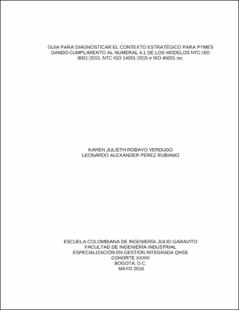| dc.contributor.advisor | Garzón Díaz, Ruth Soraya (dir) | spa |
| dc.contributor.author | Robayo Verdugo, Karen Julieth | spa |
| dc.contributor.author | Pérez Rubiano, Leonardo Alexander | spa |
| dc.date.accessioned | 2016-06-09T20:23:54Z | spa |
| dc.date.accessioned | 2021-10-01T16:18:14Z | |
| dc.date.available | 2016-06-09T20:23:54Z | spa |
| dc.date.available | 2021-10-01T16:18:14Z | |
| dc.date.issued | 2016 | spa |
| dc.identifier.uri | http://catalogo.escuelaing.edu.co/cgi-bin/koha/opac-detail.pl?biblionumber=18269 | spa |
| dc.identifier.uri | https://repositorio.escuelaing.edu.co/handle/001/392 | |
| dc.description.abstract | Small and medium-sized companies SMEs represent the main source of employment generation in the country, because they contribute about 38% of the total GDP of the nation and with the current economic crisis the most affected companies have been SMEs, which is why It is very important that they manage to optimize the business by adjusting the planning, in such a way that they become more competitive to the extent that they do not squander resources or waste business opportunities, while successfully facing the external and internal changes that arise in the medium and can compete in a highly competitive market.
As a first step it was necessary to carry out an organizational context analysis, through diagnostic and evaluation tools such as Porter's 5 forces, Profile of opportunities and threats (POAM), Internal capacity profile (PCI) and SWOT analysis of SMEs in the Health Sector, in order to facilitate the understanding of the factors that may affect the performance of the management system of these organizations.
The total deployment of the numeral 4.1 was carried out Context of the Organization of the ISO 9001: 2015, ISO 14001: 2015 and the future ISO 45001: xx, taking into account the alignment of the standards from the high-level structure for the sector PYMES - Health.
From the development of context analysis methodologies, it was evident that an organization can guide its actions with greater solidity, if it takes into account the internal and external issues of the environment in which it operates. In what concerns the sector and industry of study, the strategy of greatest impact is represented by adequate Strategic Planning, Innovation and Soundness of information management. | eng |
| dc.description.abstract | Las pequeñas y medianas empresas PYMES representan la principal fuente de generación de empleo del país, debido a que aportan cerca del 38% del PIB total de la nación y con la actual crisis económica las empresas más afectadas han sido las PYMES, por lo cual es muy importante que estas logren optimizar el negocio mediante el ajuste de la planeación, de tal forma que se hagan más competitivas en la medida que no despilfarren los recursos ni desperdicien las oportunidades de negocio, mientras enfrentan con éxito los cambios externos e internos que surgen en el medio y puedan competir en un mercado altamente competitivo.
Como primera medida fue necesario realizar un análisis de contexto organizacional, a través de herramientas de diagnóstico y evaluación como las 5 fuerzas de Porter, Perfil de oportunidades y amenazas (POAM), Perfil de capacidad interna (PCI) y análisis DOFA a las PYMES del Sector Salud, para así facilitar la comprensión de los factores que pueden incidir en el desempeño del sistema de gestión de dichas organizaciones.
Se realizó el despliegue total del numeral 4.1 Contexto de la Organización de las normas ISO 9001:2015, ISO 14001:2015 y la futura norma ISO 45001:xx, teniendo en cuenta la alineación de las normas desde la estructura de alto nivel para el sector PYMES – Salud.
A partir del desarrollo de las metodologías de análisis de contexto, se evidencio que una organización puede orientar sus acciones con mayor solidez, si tiene en cuenta las cuestiones internas y externas del medio en el que se desenvuelve. En lo que compete con el sector e industria de estudio, la estrategia de mayor impacto se ve representada por una adecuada Planificación Estratégica, Innovación y Solidez del manejo de la información. | spa |
| dc.format.mimetype | application/pdf | spa |
| dc.language.iso | spa | spa |
| dc.publisher | Escuela Colombiana de Ingeniería Julio Garavito | spa |
| dc.rights | Derechos Reservados - Escuela Colombiana de Ingeniería Julio Garavito | spa |
| dc.rights.uri | https://creativecommons.org/licenses/by-nc/4.0/ | spa |
| dc.subject | Seguridad en el Trabajo | spa |
| dc.subject | Salud | spa |
| dc.subject | Calidad | spa |
| dc.title | Guía para diagnosticar el contexto estratégico para pymes dando cumplimiento al numeral 4.1 de los modelos NTC ISO 9001:2015, NTC ISO 14001:2015 e ISO 45001:xx | spa |
| dc.type | Trabajo de grado - Especialización | spa |
| dc.type.version | info:eu-repo/semantics/publishedVersion | spa |
| oaire.accessrights | http://purl.org/coar/access_right/c_abf2 | spa |
| oaire.version | http://purl.org/coar/version/c_970fb48d4fbd8a85 | spa |
| dc.description.degreelevel | Especialización | spa |
| dc.description.degreename | Especialista en Gestión Integrada QHSE | spa |
| dc.publisher.program | Especialización en Gestión Integrada QHSE | spa |
| dc.rights.accessrights | info:eu-repo/semantics/openAccess | spa |
| dc.rights.creativecommons | Atribución-NoComercial 4.0 Internacional (CC BY-NC 4.0) | spa |
| dc.type.coar | http://purl.org/coar/resource_type/c_7a1f | spa |
| dc.type.content | Text | spa |
| dc.type.driver | info:eu-repo/semantics/bachelorThesis | spa |
| dc.type.redcol | http://purl.org/redcol/resource_type/TP | spa |
| dc.subject.keywords | Safety at work | spa |
| dc.subject.keywords | Quality | spa |
| dc.subject.keywords | Health | spa |











